| کد مقاله | کد نشریه | سال انتشار | مقاله انگلیسی | نسخه تمام متن |
|---|---|---|---|---|
| 937446 | 924485 | 2014 | 12 صفحه PDF | دانلود رایگان |
• Sexual dimorphism varies according to mating and social structure.
• Gene expression and epigenetics can modulate sex differences in neuroanatomy.
• Socialization can modify epigenetics and gene expression.
• Lowered male competition and increased female choice favor cognitive evolution.
• Human brain size was launched by pair bonding and a trend toward monogamy.
Explaining human evolution means developing hypotheses about the occurrence of sex differences in the brain. Neuroanatomy is significantly influenced by sexual selection, involving the cognitive domain through competition for mates and mate choice. Male neuroanatomy emphasizes subcortical brain areas and visual-spatial skills whereas that of females emphasizes the neocortex and social cognitive areas. In primate species with high degrees of male competition, areas of the brain dealing with aggression are emphasized. Females have higher mirror neuron activity scores than males. Hundreds of genes differ in expression profiles between males and females. Sexually selected differences in gene expression can produce neuroanatomical sex differences. A feedback system links genes, gene expression, hormones, morphology, social structure and behavior. Sex differences, often through female choice, can be rapidly modulated by socialization. Human evolution is a dramatic case of how a trend toward pair bonding and monogamy lowered male competition and increased female choice as a necessary step in releasing the cognitive potential of our species.
Journal: Neuroscience & Biobehavioral Reviews - Volume 46, Part 4, October 2014, Pages 579–590
